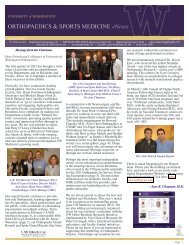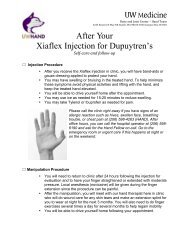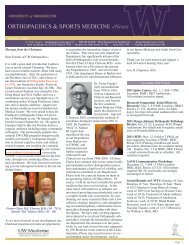2002 - University of Washington Bone and Joint Sources
2002 - University of Washington Bone and Joint Sources
2002 - University of Washington Bone and Joint Sources
You also want an ePaper? Increase the reach of your titles
YUMPU automatically turns print PDFs into web optimized ePapers that Google loves.
Complications Associated With Internal Fixation <strong>of</strong><br />
Comminuted, Bicondylar Tibial Plateau Fractures<br />
DAVID P. BAREI, M.D., F.R.C.S.(C), SEAN E. NORK, M.D., WILLIAM J. MILLS, M.D.,<br />
STEPHEN K. BENIRSCHKE, M.D., AND M. BRADFORD HENLEY, M.D., M.B.A.<br />
Complex bicondylar tibial<br />
plateau fractures are highenergy<br />
injuries that <strong>of</strong>ten occur<br />
in polytraumatized patients. Articular<br />
depression, sagittal <strong>and</strong> coronal plane<br />
condylar separation, <strong>and</strong> detachment <strong>of</strong><br />
the metaphysis from the diaphysis are<br />
defining fracture characteristics.<br />
Marked swelling, abrasions,<br />
compartmental syndrome, <strong>and</strong> open<br />
wounds commonly occur. Treatment<br />
goals include accurate articular<br />
reconstruction, restoration <strong>of</strong> knee<br />
stability, reestablishment <strong>of</strong> condylar<br />
width, maintenance <strong>of</strong> the normal<br />
mechanical axis, <strong>and</strong> stable fixation.<br />
Treatment techniques include isolated<br />
lateral plating, small wire external<br />
fixation with or without limited<br />
internal fixation, lateral plating<br />
combined with medial external<br />
fixation, <strong>and</strong> double plating.<br />
Unfortunately, medial <strong>and</strong> lateral<br />
plating, particularly through a single<br />
anterior incision, has been associated<br />
with high wound complications <strong>and</strong><br />
deep sepsis. Double plating through<br />
separate medial <strong>and</strong> lateral incisions<br />
may minimize anteromedial s<strong>of</strong>t tissue<br />
dissection <strong>and</strong> decrease significant<br />
wound complications. The purpose <strong>of</strong><br />
this study is to report the complications<br />
<strong>and</strong> infection rate associated with<br />
double plating complex tibial plateau<br />
fractures stabilized through two<br />
incisions.<br />
MATERIALS AND METHODS<br />
Over a 79 month period, all patients<br />
sustaining an intra-articular fracture <strong>of</strong><br />
the proximal tibia were collected from<br />
a prospectively designed orthopaedic<br />
database <strong>and</strong> reviewed retrospectively.<br />
This search identified 308 patients with<br />
319 bicondylar tibial plateau fractures.<br />
Ten fractures were misclassified, leaving<br />
309 fractures eligible for review. One<br />
hundred <strong>and</strong> seventy-eight fractures<br />
had simple articular involvement (AO/<br />
OTA type 41-C1 <strong>and</strong> 41-C2) <strong>and</strong> were<br />
excluded. Thirteen fractures were<br />
treated with primary amputation, five<br />
were treated non-operatively, two were<br />
treated with staged arthroplasty, 13<br />
fractures were excluded for various<br />
reasons, <strong>and</strong> 8 fractures with<br />
insufficient data for review were also<br />
excluded. The remaining 90 patients<br />
sustained 90 complex tibial plateau<br />
fractures (AO/OTA type 41-C3) <strong>and</strong><br />
formed the study group. All 90 patients<br />
were treated with plate fixation through<br />
two operative approaches. The use <strong>of</strong><br />
a single midline anterior surgical<br />
approach was ab<strong>and</strong>oned prior to the<br />
study period.<br />
There were 57 male <strong>and</strong> 33 female<br />
patients with a mean age <strong>of</strong> 44.03 years<br />
(range, 21 to 88 years). Twelve fractures<br />
were open (13.3%) <strong>and</strong> classified as<br />
type II (1 patient), type IIIA (8<br />
patients), type IIIB (2 patients), <strong>and</strong><br />
type IIIC (1 patient). Compartmental<br />
syndrome was diagnosed <strong>and</strong> treated<br />
with fasciotomies in 12 patients<br />
(13.3%). Temporary anterior spanning<br />
external fixation was performed in 45<br />
patients (50%) secondary to the<br />
severity <strong>of</strong> the local s<strong>of</strong>t tissue injury<br />
or associated life-threatening injuries.<br />
The average interval from injury to<br />
definitive surgical treatment was 8.98<br />
days (range, 0 - 40 days).<br />
Technique<br />
Medial column fixation through a<br />
posteromedial approach is typically<br />
performed first. The incision is placed<br />
approximately one centimeter posterior<br />
to the posteromedial edge <strong>of</strong> the tibial<br />
metaphysis, then parallels the sartorius<br />
<strong>and</strong> pes tendons proximally.<br />
Subperiosteal dissection is limited to<br />
the fracture edges <strong>and</strong> anticipated plate<br />
position. Disruption <strong>of</strong> the s<strong>of</strong>t tissues<br />
on the anteromedial aspect <strong>of</strong> the tibia<br />
is avoided. The posteromedial plateau<br />
<strong>and</strong> metaphyseal fracture components<br />
are reduced, provisionally held, <strong>and</strong><br />
stabilized with a posteromedial plate.<br />
Lateral column fixation is<br />
performed using a st<strong>and</strong>ard<br />
anterolateral approach. A longitudinal<br />
skin incision is made one centimeter<br />
lateral to the tibial crest curving laterally<br />
over Gerdy’s tubercle <strong>and</strong> extending<br />
proximally in a longitudinal fashion to<br />
the lateral femoral epicondyle. The<br />
iliotibial b<strong>and</strong> is incised in line with the<br />
skin incision <strong>and</strong> mobilized from<br />
Gerdy’s tubercle. A sub-meniscal<br />
arthrotomy is performed followed by<br />
provisional articular <strong>and</strong> metadiaphyseal<br />
reconstruction.<br />
Subchondral defects are bone grafted.<br />
Buttress plate fixation <strong>of</strong> the lateral<br />
column is performed with the proximal<br />
screws strategically placed to support<br />
articular comminution. Supervised<br />
knee motion is started when the<br />
incisions are secure. Patients remain<br />
non-weightbearing for a minimum <strong>of</strong><br />
twelve weeks.<br />
RESULTS<br />
Non-Septic Complications<br />
Non-septic complications included<br />
one nonunion at the proximal tibial<br />
meta-diaphysis requiring bone grafting<br />
<strong>and</strong> revision plating. Thirteen patients,<br />
exclusive <strong>of</strong> those with infections,<br />
required delayed (greater than six<br />
months from injury) implant removal<br />
for relief <strong>of</strong> local symptoms. Two <strong>of</strong><br />
these patients also underwent resection<br />
<strong>of</strong> heterotopic ossification to improve<br />
knee motion. Six patients required a<br />
knee manipulation for extension<br />
contracture, <strong>and</strong> one patient<br />
underwent tendo-Achilles lengthening<br />
for an equinus contracture. Seventeen<br />
patients incurred significant deep<br />
venous thromboses (DVT). No patient<br />
was diagnosed with pulmonary<br />
embolism. There were no deaths.<br />
Septic Complications<br />
Deep wound infections occurred in<br />
seven patients (7.78%), two <strong>of</strong> which<br />
were associated with septic arthritis.<br />
Two <strong>of</strong> the seven infections occurred in<br />
patients who sustained open injuries.<br />
One patient declined surgical or<br />
medical management <strong>of</strong> his infection.<br />
The remaining six patients had clinical<br />
resolution after an average <strong>of</strong> 4<br />
additional procedures (range 1 to 7<br />
procedures) combined with antibiotic<br />
therapy.<br />
Two patients sustained vascular<br />
injuries <strong>and</strong> were treated with vascular<br />
reconstruction <strong>and</strong> prophylactic<br />
fasciotomy. The presence <strong>of</strong> an open<br />
injury, compartmental syndrome, the<br />
12 <strong>2002</strong> ORTHOPAEDIC RESEARCH REPORT















